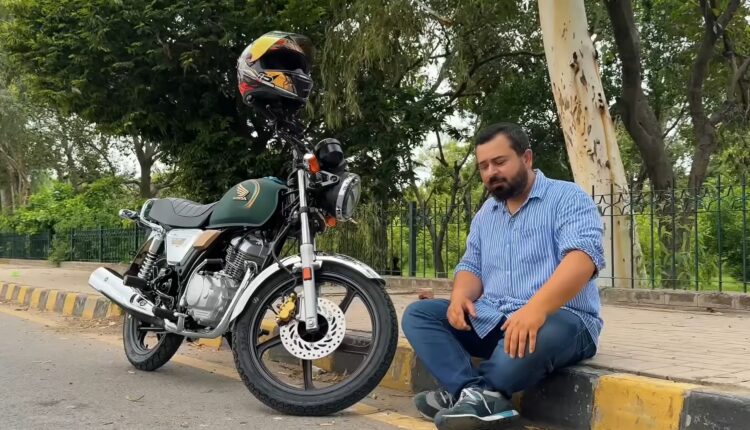Honda CG150 Test Drive Review
It’s been nearly a decade of “new sticker, same bike” from Atlas Honda—eight long years of watching the same silhouette roll out with slightly updated graphics and a new price tag. But last week, Atlas Honda pulled the covers off the all-new CG150, their first new model in eight years.
We got behind the bars to see if this long-awaited upgrade is just a puffed-up commuter or a genuine game-changer in the 150cc category. Is it worthy of the CG legacy? Or just an overpriced 150cc motorcycle?
First Impressions
At first look, CG150 gives a retro look, especially the taillight that looks identical to the ’90s CB200.
The bike isn’t shy about shining under the sun. And that’s mostly because you’ll spot plenty of chrome across the indicators, mudguards, silencer, suspension, and even the taillight. Most of the parts are either in chrome or have chrome garnishing,
Moving up to the instrument cluster, it’s the same as you see in the CB150F. You get 5-speed gear indication, fuel gauge, and dipper indicator on the meter side, along with other standard speed-o-meter things, all neatly backlit by a crisp white LED for nighttime visibility.
One good thing Honda has done here is give it alloy wheels and a disc brake up front, which is linked to the rear drum brake via CBS technology, so tyres don’t skid in emergency braking situations.
Honda CG150 Test Drive Review
Below, we’ll split the test drive review into categories for your ease of reading:
Engine Vibrations and Performance
Honda claims the CG150 comes with a balancer shaft and, being an OHC engine, you’d expect a vibration-free ride quality, right? Well, not entirely. Yes, the vibrations are there, but they’re much less compared to the CG125 or CD70. In fact, this is probably one of the smoothest Honda bikes in this category so far. That said, it still can’t beat the YBR or GS, which are ahead in vibration-free ride quality. Overall, long rides are possible on this motorcycle, and you can ride it for some hours easily without any back pain.
On the performance side it give you 11.7 HP of power and 12.5 Nm of torque and the torque delivery is good, not aggressive like the CG125, but definitely not weak either. We tested it with two riders, both over 80 kg, and gave it throttle on an uphill slope from a rest. The bike responded well. It didn’t feel like it was struggling. It’s not punchy or abrupt, but gets the job done well during overtaking and city riding.
Coming to the horsepower, we pushed the motorcycle to 95 km/h without any trouble, and it still had more to give. We’re pretty confident it can hit 110 km/h without much effort. But while the top-end feels decent for a 150cc, the initial pick-up leaves something to be desired. It’s not slow, but it doesn’t have that quick off-the-line punch that some riders might expect from a 150cc motorcycle. It builds speed steadily, not aggressively.
Suspensions
The CG150’s suspension is excellent, easily one of the best in its class, even better than the YBR. Both front and rear suspensions are super smooth and handle typical bumpy roads and small potholes with ease, they have more travel and softer than other motorcycles in the competition. Of course, if you hit a deep pothole, you’ll still feel it, it’s suspension, not magic, but for daily riding, it’s very comfortable.
Seat Comfort
The seat is comfortable, but not quite on the level of the CB150F or Yamaha YBR. The cushioning feels a bit firm at first, slightly on the harder side, but we think it’ll soften up with regular use and feel better over time. It’s good enough for daily rides, just not the most plush seat out there.
Cruising Range and Braking
We set the bike on 5th gear, maintained the 60 Km/h speed and the RPMs were on 5,700-5,800. At that speed, vibrations were minimal to none, and these RPMs will also give you the best economy.
Coming to the brakes, Honda has done a solid job here. The CBS (Combined Braking System), which applies both the front and rear brakes when you press the lever, a very useful feature for balanced braking without letting the rear tyre skid. The front has a disc brake while the rear uses a drum. Even when using just the front brake on its own, the stopping power is strong due to the disc setup. Just be careful not to press the front lever too hard, as it can cause the tire to lock up.
Verdict
The Honda CG150 brings a fresh add-on to Atlas Honda’s lineup, and overall, it does a good job. The retro design with heavy chrome, smooth suspension setup, and CBS braking system all make an impressive option in market . While it doesn’t beat the YBR or GS in vibration control or outright comfort, it holds its own with decent performance, good ride quality, and practical features. If you’re a Honda fan looking for something more refined than the CG125 but still familiar, the CG150 is worth considering.


